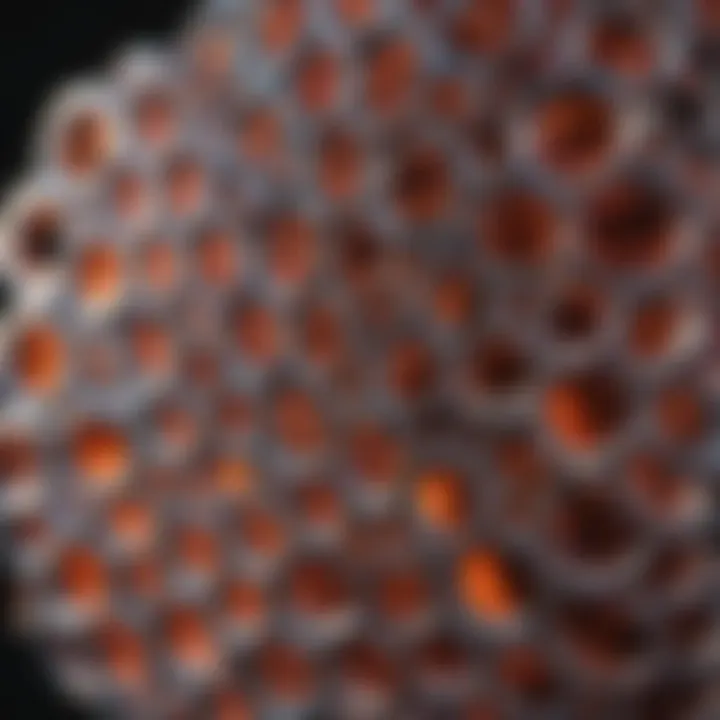Hexagonal Boron Nitride: Properties and Future Insights


Intro
Hexagonal boron nitride (h-BN) has emerged as a pivotal material within several spheres of research and application. Its two-dimensional structure and unique properties enable a wide range of functional uses, creating new opportunities in various fields such as electronics, materials science, and nanotechnology. Understanding h-BN is more than an academic exercise; it is crucial for predicting the trajectory of modern technological advancements. This narrative explores the many aspects of h-BN, from its properties to its applications and the future it holds.
Research Overview
Key Findings
Recent studies have highlighted several significant attributes of h-BN, including:
- Excellent thermal stability, making it suitable for high-temperature applications.
- Exceptional electrical insulating properties, which are crucial for semiconductor devices.
- Mechanical strength that rivals that of diamonds, while being lightweight.
Moreover, the material displays unique optical properties, such as photoluminescence. These characteristics make h-BN a material of choice in various technological advancements, particularly in the nanotechnology and semiconductor industries.
"Hexagonal boron nitride is often referred to as 'white graphene' due to its structural similarities, yet its varied properties differentiate it significantly from graphene."
Study Methodology
The research undertaken to evaluate h-BN has employed a range of methodologies, including:
- Synthesis techniques like chemical vapor deposition and boron nitride powder techniques.
- Characterization methods such as scanning electron microscopy (SEM) and atomic force microscopy (AFM) to analyze the structural integrity and properties.
These methodologies not only shed light on h-BN's properties but also guide its practical applications.
Background and Context
Historical Background
The discovery of boron nitride dates back to the early 20th century, but its hexagonal form was identified much later. Initially, research focused on boron nitride's potential as a lubricant due to its structural properties. Over the decades, the versatility of h-BN has been recognized, leading to its inclusion in various high-performance applications.
Current Trends in the Field
Currently, research trends emphasize the role of h-BN in the development of advanced electronic devices. The material's application in two-dimensional electronics is particularly promising. Innovations in nanotechnology continue to inspire fresh insights into h-BN's capabilities, where it serves as a dielectric layer in transistors and other electronic components. Moreover, the integration of h-BN into composite materials is gaining traction, enhancing the performance in industries ranging from aerospace to energy.
This structure sets the stage for further exploration of h-BN in the following sections, contributing to a thorough understanding of its properties and future potential.
Prolusion to Hexagonal Boron Nitride
Hexagonal boron nitride (h-BN) is a remarkable material that plays a pivotal role in modern science and engineering. The significance of h-BN extends across various disciplines due to its unique properties. This section aims to unveil the essential aspects of h-BN, promoting a better understanding of both its structure and its functionality.
Definition and Composition
Hexagonal boron nitride is a binary compound made of boron and nitrogen, structured in a manner similar to graphite. Each layer consists of planar hexagonal arrangements where boron and nitrogen atoms alternate. This forms a two-dimensional structure with weak van der Waals bonding between layers. The chemical formula of h-BN is BN, and it is known for being an isoelectronic analog of graphite, which imparts desirable properties such as thermal conductivity and chemical stability.
The composition of h-BN is critical in its performance; variations in boron to nitrogen ratios can lead to different properties. This material is often incorporated into products such as lubricants, coatings, and electronic components due to its resilience and insulating capabilities. Furthermore, the arrangement of the atoms may lead to different allotropes, each exhibiting varied characteristics relevant for specific applications.
Historicity and Development
The history of hexagonal boron nitride is relatively recent compared to other materials. First synthesized in the 1950s, its potential was quickly recognized for a variety of applications. Research began focusing on its structure, showing properties that were beneficial for technological advancements. In its initial applications, h-BN gained attention in the manufacturing of high-temperature insulation materials due to its thermal resistance and chemical inertness.
Throughout the last few decades, development has accelerated, especially with the rise of nanotechnology and materials science. Researchers have explored different methods of synthesis, enhancing the quality and scalability of h-BN production. This has led to its increased use in electronics and nanotechnology. With ongoing studies, h-BN is constantly being reevaluated for novel applications, enhancing its footprint in both academic and industrial domains.
The evolution of hexagonal boron nitride is a testament to the material's versatility and potential in various fields.
In summary, hexagonal boron nitride, with its unique qualities and expanding utility, has made a significant impact on material science. Understanding its composition and historical development lays a foundation for appreciating its current and future applications.
Material Properties


The understanding of material properties is essential in evaluating hexagonal boron nitride's (h-BN) capabilities across various applications. The topic encapsulates aspects such as crystal structure, thermal conductivity, electrical properties, and mechanical strength, each contributing distinctly to the material’s functional diversity. Knowing these properties not only aids in adapting h-BN for specific uses but also illuminates its role in emerging technologies.
Crystal Structure
Hexagonal boron nitride features a layered crystal structure similar to that of graphite. Each layer consists of sp² hybridized boron and nitrogen atoms, robustly bonded in a planar arrangement, while adjacent layers are held together by van der Waals forces. This unique configuration provides several advantages:
- Layered Arrangement: The ability to easily peel layers makes h-BN ideal for applications requiring thin materials.
- High Stability: The bonding structure grants excellent thermodynamic stability, vital for high-performance settings.
The orientation of these layers also greatly influences the behavior of h-BN in practical applications. Specific crystallographic orientations can enhance its thermal and electrical properties, making it vital for tailored use in nanostructures and electronic devices.
Thermal Conductivity
Hexagonal boron nitride exhibits impressive thermal conductivity, especially in the-plane direction. Its ability to efficiently transfer heat is comparable to that of metals, such as copper. This property is crucial for many applications:
- Heat Management: In electronic devices, h-BN serves as an effective heat dissipation material, prolonging the lifespan of components.
- Thermal Insulation: While conducting heat horizontally, h-BN also acts as an insulator in vertical layers, offering dual functionality in many systems.
This duality enhances the material's role in thermal management strategies, proving its relevance in semiconductor and microelectronic applications.
Electrical Properties
The electrical properties of h-BN are equally noteworthy. Despite being an electrical insulator, the material can be manipulated in various ways:
- Dielectric Strength: h-BN has a high dielectric strength, making it suitable for use in capacitors and substrate materials in high-frequency electronics.
- Field Effect Transistors: Research indicates that h-BN can function as an effective gate dielectric in field-effect transistors, improving performance in future electronic devices.
This insulating nature combined with its potential in electronic applications marks h-BN as a key player in developing next-generation materials for the electronics industry.
Mechanical Strength
The mechanical strength of h-BN is significant when considering its application in harsh environments. Several points highlight its importance:
- High Hardness: The material's strength allows it to withstand considerable pressure and wear, making it useful in abrasive applications and coatings.
- Flexibility: Despite its hardness, layered h-BN can also exhibit flexibility, allowing it to be formed into various shapes without degradation.
The combination of hardness and flexibility makes h-BN an attractive candidate for many industrial applications, from manufacturing processes to advanced mechanical systems.
"The unique properties of hexagonal boron nitride position it as a critical material for future advancements in technology, particularly in semiconductor and nanotechnology realms."
In summary, the material properties of h-BN are crucial for its diverse applications. Understanding its crystal structure, thermal conductance, electrical traits, and mechanical strength allows researchers and engineers to exploit its unique characteristics efficiently.
Synthesis Methods
Synthesis methods of hexagonal boron nitride (h-BN) are key to unlocking its potential in various applications. Understanding these methods is crucial as they influence the quality, purity, and properties of the produced material. Each technique offers unique benefits and considerations, impacting how effectively h-BN can be utilized in different fields. Manufacturing processes must be efficient and consistent to support the growing interest and demand for h-BN in research and industry.
Chemical Vapor Deposition ()
Chemical Vapor Deposition is one of the most widely used techniques for synthesizing hexagonal boron nitride. It involves creating a gaseous phase which reacts and deposits h-BN onto a substrate. This method allows for precise control over the thickness and quality of the material, making it highly suitable for applications in electronics and nanotechnology.
In CVD, boron and nitrogen precursors are introduced into a reaction chamber at elevated temperatures. This initiates a series of chemical reactions leading to the formation of h-BN films. Important factors such as temperature, pressure, and concentration of the precursors must be optimized to achieve the desired properties. The CVD process typically yields high-purity h-BN with excellent crystallinity, which is crucial for its electronic properties.
CVD is favored in industrial applications due to its ability to produce large area h-BN films that have consistent properties.
Bulk Synthesis Techniques
Bulk synthesis techniques are another route for producing hexagonal boron nitride. These methods encompass various approaches, including solid-state synthesis, where boron and nitrogen sources are combined and subjected to high temperatures and pressure.
One popular method is the high-temperature reaction of boron oxide with nitrogen gas, resulting in crystalline h-BN formations. Although bulk techniques can yield larger quantities of material, they often come with challenges regarding control over the material's microstructure and purity. The resulting h-BN might not exhibit the same levels of quality or performance seen in thin films obtained via CVD. Nonetheless, bulk synthesized h-BN is valuable in applications requiring larger volumes, such as in lubricants and coatings.
Microwave-Assisted Methods


Microwave-Assisted methods present an innovative alternative for synthesizing h-BN. By utilizing microwave radiation, heat is uniformly distributed within the reaction mixture, allowing for faster synthesis times and potentially leading to superior material properties.
In these methods, boron-containing and nitrogen-containing precursors are mixed and placed in a microwave reactor. The microwave energy facilitates the rapid reaction between the precursors. This method promises enhanced control over the growth process and can produce h-BN powders with unique characteristics.
The efficiency and speed of microwave-assisted synthesis could open new avenues for h-BN applications in nanotechnology and biomedical fields. However, it is essential to consider the scalability of this method for industrial purposes, as current challenges relate to equipment costs and knowledge on process optimization.
Applications of Hexagonal Boron Nitride
Hexagonal boron nitride (h-BN) presents an array of applications across various fields due to its unique properties. From electronics to nanotechnology and biomedical fields, the versatility of h-BN stems from its exceptional thermal, electrical, and mechanical characteristics. Understanding the applications of h-BN is essential for recognizing its significance in contemporary science and technology. This section delves into the numerous applications of h-BN, illuminating its critical role in different industries and potential future advancements.
In Electronics
h-BN is widely recognized for its role in the electronics sector. It serves as an effective dielectric material, making it useful in the development of electronic devices. Its high thermal conductivity allows for better heat dissipation, which is crucial for semiconductor devices. Furthermore, h-BN's chemical stability ensures reliability in various environments, increasing the lifespan of electronic components.
Key advantages of h-BN in electronics include:
- High thermal efficiency: This characteristic aids in maintaining optimal operating temperatures for components like transistors.
- Electrical insulation: h-BN effectively prevents electrical leakage, ensuring efficiency in high-power devices.
- Scalability: It can be manufactured in large sheets, which is beneficial for large-scale production in the industry.
In Lubricants and Coatings
In the realm of lubricants and coatings, h-BN is valued for its low friction properties. It acts as a solid lubricant that enhances the wear resistance of mechanical components. When added to lubricants, h-BN improves performance in extreme conditions such as high temperatures and pressures. This can lead to reduced wear and prolonged lifespan of machinery.
Some specific benefits of h-BN in this application area are:
- Non-toxic nature: Unlike traditional lubricants, h-BN does not release harmful substances, making it more environmentally friendly.
- Thermal stability: It can withstand higher temperatures, thus maintaining lubrication properties under extreme conditions.
- Wide compatibility: h-BN can be mixed with various types of oils and greases, enhancing their performance.
In Nanotechnology
The applications of h-BN in nanotechnology are particularly significant. h-BN nanosheets have gained attention due to their high strength and stability. These nanosheets can be used as insulating layers in two-dimensional materials, which is crucial for developing advanced electronic devices. Their unique structure also offers potential in creating novel composite materials with superior properties.
Notable points regarding h-BN in nanotechnology include:
- Enhanced mechanical properties: The addition of h-BN can improve the strength of nanocomposites without adding significant weight.
- Versatile applications: h-BN nanosheets can be used in energy storage devices and sensors.
- Surface modification: It has the ability to modify surface properties of materials, leading to enhanced performance in various applications.
In Biomedical Applications
Hexagonal boron nitride has emerging applications in the biomedical field, specifically in drug delivery and biosensing. Its biocompatibility makes it suitable for various medical applications. Researchers are exploring the use of h-BN for drug carriers due to its ability to encapsulate therapeutic agents effectively. Furthermore, its excellent surface characteristics may enhance biosensing capabilities, allowing for improved disease detection methods.
Key aspects of h-BN’s role in biomedical applications include:
- Targeted drug delivery: h-BN can potentially deliver drugs directly to targeted cells, reducing side effects.
- Biosensors: Its conductive properties may aid in developing sensitive biosensors for real-time health monitoring.
- Tissue engineering: h-BN can be used as a scaffold material for tissue growth because of its structural properties.
The applications of hexagonal boron nitride are far-reaching, showcasing its potential across diverse fields from traditional electronics to innovative biomedical solutions.
Current Research Trends
The study of hexagonal boron nitride (h-BN) has shifted to focus on innovative applications and synthesis methods. The importance of these trends cannot be understated; they reveal the compound's potential and address pressing needs across various industries. Researchers are investigating h-BN not just for its inherent qualities but also how it can synergize with other materials. The exploration of h-BN is key to elevating technologies, particularly in nanotechnology and electronic devices. Understanding these trends helps in realizing the broader implications of h-BN's unique characteristics.
Advancements in h-BN Nanostructures
Recent advancements in nanostructures of h-BN are significant. Researchers are exploring methods to create h-BN in forms such as nanosheets. These nanosheets present advantages like high thermal stability and electrical insulation, pivotal for electronic applications. One important characteristic of h-BN nanosheets is their two-dimensional structure, which enhances surface area. This property allows them to interact with other materials effectively. The development of h-BN nanostructures also opens doors for potential use in energy storage systems.
The synthesis of these nanostructures often combines techniques like chemical vapor deposition and liquid exfoliation. Researchers are keen to refine these processes for better quality and yield. Studies have shown that controlling the size and defects in h-BN nanosheets can drastically affect their performance.
"Nanostructured h-BN holds promise for next-generation devices. Its unique properties are invaluable for various applications."
Integration with Other Materials


The integration of h-BN with other materials is another area of active research. This focus can enhance the overall material properties and expand its applications. For instance, combining h-BN with graphene can yield composites that maintain excellent electrical conductivity while benefiting from h-BN’s thermal properties. This hybrid material is especially useful for the development of heat management systems in electronics.
Another example includes integrating h-BN in polymer matrices to create advanced composites. These composites can exhibit improved mechanical properties and resistance to wear and tear. The versatility of h-BN enables it to be functionalized with other materials, giving it new capabilities suited for specific applications.
In summary, the integration research highlights the potential for innovative solutions in electronics, aerospace, and materials science. Understanding these collaborative interactions enhances the capabilities of both h-BN and the materials it is combined with.
Challenges and Limitations
Understanding the challenges and limitations associated with hexagonal boron nitride (h-BN) is crucial for its continued development and application in various fields. Despite its many advantages, h-BN faces several hurdles that can impede its broader acceptance and utilization. This section will examine significant factors such as cost of production, material purity and quality, and scalability issues, each playing a vital role in the future of h-BN technologies.
Cost of Production
The cost associated with the production of hexagonal boron nitride can be significant. Various synthesis methods, such as Chemical Vapor Deposition (CVD) and bulk techniques, require substantial investment in equipment and materials. These costs may not justify the benefits for all potential applications, especially when competing materials are available at lower prices. Furthermore, any fluctuation in raw material prices can directly impact overall production costs. In some industries, the economic feasibility of integrating h-BN may hinge on these cost considerations. Thus, ongoing research into more cost-effective production methods is needed to broaden its range of applications.
Material Purity and Quality
Material purity and quality are critical factors for h-BN, particularly in high-stakes applications like electronics and nanotechnology. Impurities in the h-BN structure can lead to compromised mechanical and thermal properties, thus reducing performance quality. Quality control during production remains a challenge. Measuring and maintaining the required levels of purity is necessary to ensure the consistency of h-BN's properties. Researchers are exploring quality enhancement techniques, but the challenge of achieving consistently high-quality h-BN persists. As usage evolves, strict quality standards will be necessary to meet industry demands.
Scalability Issues
Scalability of hexagonal boron nitride production also presents challenges. Many synthetic methods that yield high-quality h-BN are typically limited in production quantity. To meet increasing demand for h-BN in various sectors, scaling up production while maintaining quality remains a pivotal issue. Research and innovation in this area could lead to breakthroughs in manufacturing processes. Identifying pathways for large-scale production without sacrificing performance will be essential in the quest to integrate h-BN into mainstream applications.
"The scalability of production methods for h-BN is as crucial as the methods themselves, as demands in industry continue to rise."
Future Perspectives
The exploration of hexagonal boron nitride (h-BN) continues to reveal a wealth of opportunities. Its unique properties open various paths for innovation and application, presenting significant implications for multiple industries. Understanding future perspectives is crucial as it informs researchers and professionals about promising directions that could leverage h-BN capabilities, driving advancements in technology and sustainability.
Potential Innovations in Usage
In the quest for new applications, several key areas show promise for the innovative use of hexagonal boron nitride. These include:
- Nanoelectronics: h-BN's excellent electrical properties make it well-suited for transistor technology. Future research can look into its integration with emerging 2D materials like graphene, which may lead to new forms of ultra-fast transistors.
- Thermal Management: Innovations may arise in heat dissipation technology. h-BN is known for high thermal conductivity. This can be incredibly useful in devices that generate significant heat, including LEDs and high-power electronics.
- Biocompatible Coatings: Given its chemical stability, research into using h-BN in biocompatible coatings for medical devices may yield significant benefits. Its properties could reduce the risk of infection and improve the longevity of implants.
These innovations not only increase the utility of h-BN in existing sectors but also encourage interdisciplinary collaboration, propelling advancements in nanotechnology, semiconductor research, and biomedical fields.
Environmental Impact Assessment
As research progresses into the applications of hexagonal boron nitride, it is vital to consider the environmental impact. Assessments of h-BN production and usage are essential to ensure its sustainability. Some points to address include:
- Resource Utilization: The production methods of h-BN must be evaluated for resource consumption. Synthesis techniques should be optimized to minimize waste and maximize yield.
- Toxicity Levels: There needs to be ongoing research into any potential toxicity associated with h-BN, especially relevant in biomedical applications. Understanding its interaction with biological systems will be important.
- Lifecycle Analysis: A complete analysis of the lifecycle of h-BN products should be conducted, from raw material extraction to end-of-life disposal. This can help identify areas for improvement that may reduce carbon footprint and other environmental impacts.
It is essential for future research to focus not only on the functional benefits of h-BN but also on its environmental sustainability. Such considerations are important for the enduring viability of h-BN in various applications.
Closure
The conclusion of this article plays a crucial role in summarizing the essential aspects of hexagonal boron nitride (h-BN) and offering insight into its future trajectory. As demonstrated throughout the sections, h-BN is not merely a novelty within the realm of materials science; it is a versatile compound that has significant implications across various fields such as electronics, nanotechnology, and biomedical applications. Its unique properties—like high thermal conductivity, excellent electrical insulation, and remarkable mechanical strength—position h-BN as an invaluable material in modern technological advancements.
Summary of Key Points
The examination of h-BN has revealed several key points:
- Material Properties: h-BN is notable for its exceptional thermal conductivity and mechanical strength while being an effective electrical insulator. These properties make it an attractive option for various applications.
- Synthesis Methods: The methods for synthesizing h-BN, including Chemical Vapor Deposition and microwave-assisted techniques, play a significant role in determining the purity and quality of the material, which are crucial for its applications.
- Applications Overview: h-BN finds use in diverse domains such as electronics, lubricants, and nanotechnology, and shows potential for future biomedical applications.
- Current Research Trends: Trends show that ongoing research is focused on enhancing h-BN nanostructures and exploring its integration with other materials, indicating a growing interest in its multifunctional capabilities.
- Challenges and Limitations: While the benefits of h-BN are substantial, challenges such as high production costs, purity issues, and scalability need to be confronted to fully exploit its potential.
Call for Future Research
Future research is essential for unlocking the full potential of h-BN. Several avenues could be explored:
- Investigating new synthesis techniques that reduce costs while ensuring high purity and quality.
- Exploring innovative applications that leverage the unique properties of h-BN in fields such as energy storage or advanced medical devices.
- Conducting environmental impact assessments to understand the implications of large-scale h-BN production and use.
The research community must prioritize these areas to advance knowledge and develop practical applications of hexagonal boron nitride. Collaboration among scientists from diverse disciplines will be critical in overcoming existing limitations and innovating new uses for this remarkable material.
By understanding and addressing the challenges associated with h-BN, we can foster an environment where the material can thrive in various applications, ultimately contributing to advancements in science and technology.







